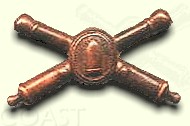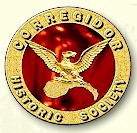|
|
 |
|
|
|

Questions From Our Visitors |
|
Who or what is Fort Drum named for? |
|
|
War Department General Order 245, dated Dec. 13, 1909, named Fort Drum in honor of General Richard Coulter. Drum,
"who served with distinction during the
Mexican War and the Civil War."
Part of that distinction was political - he was largely instrumental in
checking the Succession movement in California, which, had it continued,
may well have assured the success of the South. He eventually became
Adjutant General in 1880 under President Cleveland's first
administration. He died October 15, 1909
There
does not appear to be any connection between Gen. Drum and the
Philippines.

General Richard C
Drum - Information Click Here
|
|
Where was the Battery
McCrea position on Ft. Drum? I understand it was named for Tulley McCrea
who commanded a battery at Gettysburg. That battery killed my great, great
granddaddy who served with the 26th NC on the 3rd day and was killed at
the angle. (Al Wright). |
|
|
Tulley McCrea.
Born in Mississippi ca 1840
Appointed to USMA from Ohio 1858
Appointed 2nd Lt 1st Artillery 6-17-1862
Received brevet promotion to 1st Lt for gallantry
and meritorious service at Battle of Antietam September 17, 1862. Received
brevet promotion to Captain for gallantry and meritorious service at
Battle of Gettysburg July 3, 1863
Promoted 1st Lt 11-4-63
Received brevet promotion to Major for gallantry and meritorious service
at Battle of Olustee, February 20, 1864
Served as regimental quartermaster, 1st Artillery 6-20-to 11-20-1866
Promoted Captain, 42nd Infantry 7-28-1866 [refused?]
Served as unassigned 4-22-69 when reassigned to 1st Artillery, 12-15-1870
Promoted Major and transferred to 5th Artillery12- 4-1888
Promoted Lt Colonel 3-8-98
Promoted to Colonel and transferred to 6th Artillery 7-15-1900
Transferred to Artillery Corps February 2, 1901
Promoted Brigadier General, February 21, 1903
Retired February 22, 1903 with 45 years of service
First post commander of Fort Hancock New Jersey.
Many thanks to Bill Gaines and Mike Murray of the CDSG for the
biography
|
|
Is there a roster of
troops who were at Ft. Drum when Corregidor surrendered?
(Al Wright). |
|
|
There are copies of four
pages on the website. Click
Partial Rosters Fort Drum (March 1945)
on the Table of Contents page.
|
|
Greetings, I hear 2 stories and looks like
you could set the record straight. One is that Ft. Drum can still be
toured, the other says it is closed. Which one is correct?
Thanks, Michael |
|
|
Response From Terry McGovern (CDSG).
"Fort Drum is an abandoned site. It has no fresh water or electrical
power. Access is by boat through one of the two sally ports or
landing on the top deck by helicopter. Depend on the type of boat you
have and the sea state getting aboard can be very difficult. The
sally port entrance is about six feet above sea level and there is no
protection for the boat hull against the raw concrete on site. The
standard banca is very low in the water and given the outriggers cannot
come alongside. I have visited the Fort four times and each landing has
been very different due to the type of vessel and the weather. Once inside
you can visit shatter remains of the various levels. You must take
care as it is very dark and there are holes the weaken floors (due to the
removal of the “I” beams throughout). You can climb your way to the
top deck though the remains of one of the 6-inch emplacements. The
bottom line is that you visit at your own risk and you need to prepare in
advance for gaining access.
|
|
-o-0-o- |
|
|
Hi,
I read your
site because I have been inside Fort Drum. I read in your question and
answer that it cannot be toured.
I am a
Filipino and the answer is YES there is a tour. Sun Cruises makes that
tour. True, bancas cannot do the tour but now there are bigger bancas that
can safely make you enter Fort Drum. If you want a proof, just email me
and I can send you pics that we are inside Fort Drum. The whole 34 people
where we made this summer company outing just last week. Thanks for the
site. Our employees were thrilled to be inside Fort Drum. We even wrote
our names on the cannons (hehe with rocks and just scrapping the rust. No
harm done though and took a pic also). :-)
Just making
this record straight.
Thanks
Bobby
|
|
|
|
|
Does anyone have any information on
Walter P. Allen ? |
|
|
My uncle was stationed
on Fort Drum at the start of WWII. He was in the Army and a
POW in
Japan during the war working in mines. He told me that
he was at a machine gun for 32 hours during the battle. His
name was Walter P. Allen, though his real name is Walter Allen
Wycoff. He was from
Gardena, California. I believe he was a Private.He lost three
fingers on one hand and had a lot of shrapnel in his hand. He
had his little finger and thumb left, so he could still do a lot of
things. He died several years ago.
Does anyone of your
group know anything about him?
|
|
Will Fort Drum
Ever be Restored as a Historical Shrine? |
|
|
Thanks
much for the great website about Fort Drum.
I have a
fantasy about this gallant old warhorse. My favorite daydream is
about it being restored to its former glory and serving as a shrine in
honor of the defenders in the 1941 - '42 campaign. Yes,
Corregidor has been fairly well-preserved as a shrine, but Fort Drum
should also be equally well cared-for; after all, it is the most
visible symbol of the Philippine defense, sitting right at the
entrance to Manila Bay. How nice it would be if it could be set
up in a manner similar to the Alamo in
San Antonio, Texas, complete with interpretive center and
guides.
I don't know if this will ever happen,
but one can still dream...The good Lord willing, maybe this could
come about some day.
Thanks
Ed Lofquist
|
|
Looking For Information on PFC
Andrew Galayda of Trenton, NJ, |
|
|
Dear Sir,
My uncle, PFC Andrew Galayda of Trenton, NJ, was serving in the Coast
Artillery Corps at Corregidor, and likely served from time to time on Fort
Drum, when Corregidor fell on 7 May 1942. He was captured by the Japanese
forces. In June 1945, my father received word from the War Department that
the Japanese Government, in communications via the International Red
Cross, included my uncle's name on a list of POWs lost on 24 October 1944,
when the ship in which he was being transported with 1,775 other POWs, was
sunk by submarine action in the South China Sea, while the POWs were being
transported from the Philippine Islands to Japan.
My uncle was captured with the forces, military and
civilian, on Corregidor Island on 7 May 1942, held in POW Camp #1 in the
Philippines until 11 October 1944, when he was loaded onto the
civilian-controlled Japanese ship the Arisan Maru with nearly 1,800 other
POWs for transit to Japan. On 24 October, a little after 5 in the
afternoon, the Arisan Maru was sunk by an American submarine, either by
the U.S.S. Shark or U.S.S. Snook, the records are uncertain; the Shark was
sunk later during that patrol and the USN ended up giving credit for the
sinking of the Arisan Maru to the Snook, but again, records are uncertain.
From what I read, now available on the World Wide Web, the sinking of the
Arisan Maru resulted in the greatest number of American lives lost in a
single ship loss.
Does anyone have any information please on PFC Andrew Galayda?
Thank you.
Sincerely,
Thomas A. Galayda
Lt. Colonel, USAF (Ret)
Rome, New York
[email protected]
|
|
|
|
|



